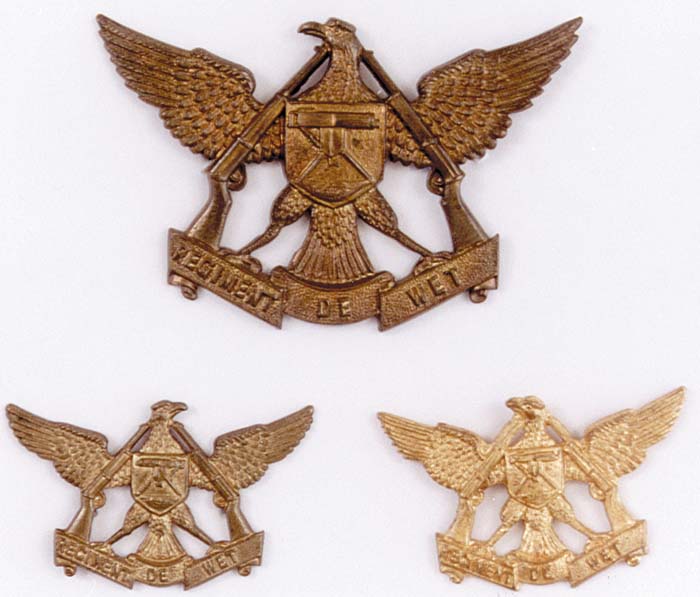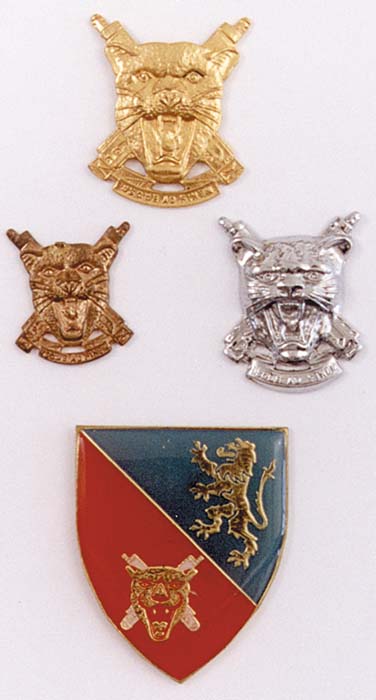By Robert G. Segel
South Africa has had a long and diverse history and was a proving ground for the practical testing of the new Maxim gun. From that beginning, a long lasting relationship developed with the South African armed forces and the Maxim and Vickers machine guns.

The image of the Maxim or Vickers has played a key part in many of South Africa’s insignia. From cap and collar badges to shirt and beret badges, arm flashes and patches and breast badges, it is an integral part of South Africa’s history.
In World War I, South Africa, as part of the British Empire, used a lot of Imperial British insignia as well as specific South African regimental badges. One interesting cap badge belonged to the South African Horse Machine Gun Section (1916-1919) which featured the Maxim gun on a flaming bomb. They operated in German East Africa during the war.

On April 1, 1934, under the First Nationalist Government of General J.B.M. Hertzog, the first five Citizen Force Regiments were formed in South Africa as part of the South African military modernization program. What made these units unique is that they were named after South African folk heroes rather than members of the Royal Family or their Colonel in chief as was typical in Commonwealth countries up to that time. This was quite a departure in terms of naming units and provided quite a bit of national pride to have these units reflect South African history. What is particularly interesting is the image and use of the venerable Vickers gun and Maxim gun as part of the design on three of the five units that were machine gun regiments.

The first unit formed, an infantry regiment, was Regiment Botha. Louis Botha was the Boer War Commander in Chief and was the first Prime Minister of the Union of South Africa. He was also responsible for taking South Africa on the side of the Allies in World War I and defeated an Afrikaaner rebellion that then led to the campaign to eliminate the Germans from South West Africa. During World War II, the Regiment served in the East and North Africa campaigns where they suffered terrible casualties as well as in Italy.

The second unit formed, a machine gun regiment, was Regiment President Steyn at Bloemfontein. President Steyn was the President of the Orange Free State Republic from 1896 to 1902. This Regiment also served in North Africa and Italy during World War II. Because of the high number of casualties suffered by both Regiments Botha and President Steyn in the North Africa campaign, the two units were amalgamated during the Italian campaign. The Vickers machine gun is the central figure of their badges.
The third regiment formed, a machine gun regiment, was Regiment Louw Wepener. He was the Orange Free State Commandant who lost his life in 1859 during the second Basuto war while storming the hilltop fortress of Moshweshwe at Thaba Bosigo. (He also gave his name to a town, the battle at which resulted in the bar ‘Wepener’ on the Queens South Africa Medal.) The volunteers of this regiment were drafted to Regiment President Steyn during World War II. Their badge, with a central image of the Vickers, is a stylized view of the mountain fortress at Thaba Bosigo.
The fourth unit formed, also a machine gun regiment, was Regiment De Wet. De Wet was the Boer General who confounded the British in the Orange Free State. The volunteers of this regiment were also drafted into Regiment President Steyn during World War II. The old Maxim gun sits squarely in the center crest.
The fifth regiment formed was an infantry regiment named De la Rey after the Boer General known as the “Lion of the Western Transvaal”. In World War II its men served in the Union until 1943 when they were amalgamated with the Witwatersand Rifles, serving in Italy.
The next batch of “Named Units” occurred on January 1, 1954. While Afrikaaners of all sorts were honored, the only unit to use the image of the Vickers machine gun was Regiment South Western Districts (R.S.W.D.) which then changed its name to Regiment Langenhoven. Langenhoven was an Afrikaaner poet and author of the South African national anthem. The crossed Vickers can be seen on both of their badges behind the Protea, South Africa’s National Flower.
In the 1960s, the South West Africa Territory Force was formed and included Regiment Erongo whose badge was crossed Vickers behind a snarling leopard head. This unit was disbanded in 1989 when South West Africa became Namibia. In the late 1960s the Military Gymnasium was created. The Military Gymnasium is what South Africa calls their All Arms School for the three primary services. The insignia features a pair of upraised wings representing the Air Force, and in the center is a Vickers machine gun representing the Army superimposed over an anchor representing the Navy.
The old Vickers finally succumbed to its obsolescence and the image of the AK-47 and Armscor R4 and R5 replaced it as the machine gun image of modern times. (The Armscor R4 is the South African version of the Israeli Galil.) Nevertheless, South Africa’s long association with the value of automatic weaponry in its arsenal continues to this day.
(My sincere thanks to Steve Seargent who provided much of the historical background for this article.)

Brass cap and collar badges and arms flashes for Regiment Louw Wepener. The small collar badge is gold gilt and was worn on the officer’s mess dress. The Regiment Louw Wepener badge truly incorporates the African heritage prominently featuring the Vickers on tripod in profile against the mountain fortress of Thaba Bosigo and an African native shield with crossed spears. 
The brass cap and collar badges of Regiment De Wet display the Maxim gun in the center crest. 
Various insignia for the South Africa Military Gymnasium. An All Arms School for all services, the wings, Vickers and anchor represent the Air Force, Army and Navy. 
Brass cap and collar badge of the 1st Transvaal Machine Gun Squadron (1932-1936) featured crossed Vickers beneath the squadron coat of arms. 
The cap, collar, beret and arm flash for the South West Africa Territory Regiment Erongo. The snarling leopard head seems to leap from the crossed Vickers behind it. 
The top brass cap badge of crossed Vickers behind the Protea, South Africa’s national flower, was issued to the R.S.W.D. (Regiment South Western District). The brass cap and collar badges below it are for the renamed R.S.W.D. to Regiment Langenhoven. 
South African 101st Romeo-Mike companies (hunter-killer companies) enamel arm flash depicting eagle with broken AK-47 (1985-1989). This unit fought in Angola.
| This article first appeared in Small Arms Review V4N11 (August 2001) |











